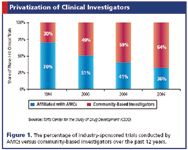Industry Trials Poised to Win Back Academia
Applied Clinical Trials
After parting ways in the late 90s, academic medical centers are revisiting industry-sponsored clinical trials.
The privatization of clinical research is widely known. Up until the early 1990s, academic medical centers (AMCs) were the primary and predominant home of industry-sponsored clinical trials. As these programs became larger and more complex and costly, industry sponsors grew tired of the inherent inefficiencies in working with academia, including protracted contractual and budget negotiations, bureaucratic and slow-moving institutional review boards (IRBs), and higher relative costs associated with poorer performance.

Kenneth A. Getz
Community-based for-profit investigative sites rapidly filled the void. Most notably to support Phase III programs, industry sponsors engaged ever-higher numbers of private physician practices and dedicated research centers to conduct their clinical trials. AMCs remained involved, to a lesser extent, by virtue of their vast scientific expertise, reservoir of ideas and intellectual property, and their influence as thought leaders.
Today, only one-third of all industry-funded clinical trials are placed within academic clinical trial offices, according to the latest data from the Tufts Center for the Study of Drug Development [see Figure 1]. During the past decade, AMCs have lost nearly 40 percentage points in market share of total industry sponsored clinical trial grants. For many AMCs, the fall from a market-leading position is without regret.

Figure 1
Whereas the mid-1990s saw a flurry of academic institutions establish clinical trial offices to better handle industry relationships, the late 1990s through mid-2000s saw a reversal of that trend. AMCs cite a number of explanations for this shift, including poor returns on infrastructure investment, lack of institutional support, and renewed emphasis on the more prestigious government-funded clinical research programs.
During the most recent five-year period between 2002 and 2007, total funding by the National Institutes of Health (NIH) grew nearly 4% annually to $28.8 billion FY2007. Next year, however, the Bush administration has abruptly halted this growth in proposing a 2% decline in the NIH budget (FY2008 $28.3 billion). That is just the tip of the iceberg. The NIH is beginning to phase out its long-established General Clinical Research Center (GCRC) program and is moving to a new Clinical and Translational Science Awards (CTSA) model. The result will be an intensification of competition specifically for NIH clinical research grants.
Many within academic circles are turning their eyes again toward industry-sponsored clinical trials as a vital source for much-needed financial resources in the near future. Fortunately, many clinical research professionals within pharmaceutical and biotechnology companies remain interested in forging, and in building, stronger relationships with academia. Indeed, a number of major sponsors including Novartis, AstraZeneca, Lilly, and Merck have been giving partnerships with AMCs greater attention.
Need and potential
"Leading AMCs have done an excellent job of making course corrections," says Ellis Wilson, section director for CV and GI at AstraZeneca. "We're seeing a growing number of AMCs paying more attention to industry, and that is a very positive development."
"At this time AMCs are not as competitive as they could be, but they hold a great deal of potential," says George Betts, executive director, U.S. medical operations for Novartis. "They have so many patients that could be eligible for clinical trials. This is not just a benefit for major drug companies. It also gives patients access to drugs not yet available on the market," he said.
"[But] AMCs that want to be back in the game need to be more efficient," said Betts. "Minimizing delays due to drawn-out negotiations over intellectual property rights would be a good place to start. And coming to terms on contractual agreements rarely goes smoothly. New lawyers cycle in and want to renegotiate everything for the AMC. Slow IRB review is also a perennial problem in desperate need of attention," he said.
"AMCs, by their nature, are picky about the trials they accept," says Kenny J. Simansky, PhD, vice dean of research at Drexel University College of Medicine. "They are mission-bound to focus on the most significant clinical care issues and economically pressed to capitalize on moving their own in-house research from bench to bedside."
"On the other hand, obtaining federal funding—notably from the NIH—has become an incredibly competitive undertaking," added Simansky. "It's silly not to go after industry-sponsored trials. They allow early access to agents and devices that don't warrant investigation by the NIH but can make an immediate contribution to clinical care," he said. "More importantly, industry provides the financial wherewithal to grow a sustainable research enterprise. That fact cannot be ignored."
Posturing for growth
Whereas many AMCs are considering whether to make a more concerted push to expand their involvement in industry-funded clinical research activity, others have been implementing new strategies and tactics designed to improve their ability to compete for industry study grants. The Biomedical Research Alliance of New York (BRANY), for example, has been proactively implementing centralized support services to expedite study start-up across its network.
Founded in 1998 by a collaboration of five New York City medical schools, BRANY now includes 235 sites (mostly AMCs or academic affiliates) across 32 states able to use a single contract, IRB, and budget. It has accepted and started 2313 pharmaceutical trials to date and evaluated hundreds more, reports CEO Eileen Hilton, MD. Although BRANY revenues have seen double-digit growth for years (30% in 2005), research revenues among its network of sites still derive mostly from federally funded projects.
Washington University School of Medicine in St. Louis started a similar collaborative a few years ago, known as Multi-center Academic Clinical Research Organization (MACRO). "We are currently resurrecting MACRO from the original concept to a slightly different format that is efficiency driven," says Phyllis Klein, director of regulatory support and compliance at the School's Center for Clinical Studies. "We are partnering with an industry sponsor and running a pilot project to get three sites up and running within 40 days. If the pilot is successful, we will be looking to add other sites," she said.
Like a growing number of AMCs, Drexel University College of Medicine has turned over the review of industry-sponsored studies to a central, commercial IRB. "Protocol approval times have decreased from four or five months to 15 business days," says Donna Jones, executive director of the Clinical Research Group. "To be competitive, we have to offer higher levels of efficiency," she added.
Spreading awareness
In November, Drexel teamed up with Thomas Jefferson University, Temple University, University of Pennsylvania, and the University of the Sciences to hold an AWARE-for-All program in Philadelphia. The program provides public education and outreach and offers strong local visibility for academic institutions conducting clinical trials. "It's important that AMCs demonstrate a commitment to assisting the public in making informed decisions about clinical research and in raising awareness of the important contribution that subjects make when they enroll in clinical trials," says Simansky. "Industry sponsors recognize the key role that AMCs play in serving the health care community."
"The University of Pennsylvania School of Medicine has seen a nearly 45% jump in government-funded research over the past five years. But its volume of industry-sponsored trials has leveled off during that time period," said Gregg Fromell, MD, executive director of the School's Office of Human Research. "We are looking to do more to increase our attractiveness to industry sponsors and to become a true home for all sponsors of clinical research," Fromell said.
A pendulum swings
Rising financial pressures will prompt many AMCs to expand their involvement in industry-funded clinical trials over the next several years. The NIH Roadmap for Medical Research and its push to establish Clinical and Translational Science Awards will also serve as a catalyst in driving up AMC commitment to industry-sponsored clinical trials.
By 2012, the NIH initiative will be providing approximately $500 million annually to 60 AMCs in order to encourage more effective interaction and communication between clinical research and medical practice. "The goal is to give every clinician in the United States an opportunity to be involved in, and connected to, clinical research irrespective of funding source," said Fromell.
Long term, the NIH is banking on clinical research that translates into better treatments that impact clinical care. To continue to receive government funding under the CTSA umbrella, academic institutions must attract more industry studies. "Whether the change in approach by the NIH will make industry studies look more attractive to AMCs remains to be seen," said Simansky "We're going after industry funding no matter what," he added.
"Every flagship company is now talking about relationship building with AMCs. Novartis has been holding road shows around the country to discuss what can be done to help speed trial startup, such as changes to document formatting and use of electronic document management," said Betts.
"By mitigating bottlenecks on the critical path, academic sites are becoming more attractive and may even start to account for a growing proportion of trial placements. The pendulum is swinging back in their direction. And pharmaceutical companies want to be their partner of choice," concluded AstraZeneca's Wilson.
Kenneth A. Getz MS, MBA, is a Senior Research Fellow at the Tufts CSDD and Chairman of CISCRP, both in Boston, MA, email: kenneth.getz@tufts.edu

Improving Relationships and Diversifying the Site Selection Process
April 17th 2025In this episode of the Applied Clinical Trials Podcast, Liz Beatty, co-founder and chief strategy officer, Inato, discusses a number of topics around site engagement including community-based sites, the role of technology in improving site/sponsor relationships, how increased operational costs are impacting the industry, and more.